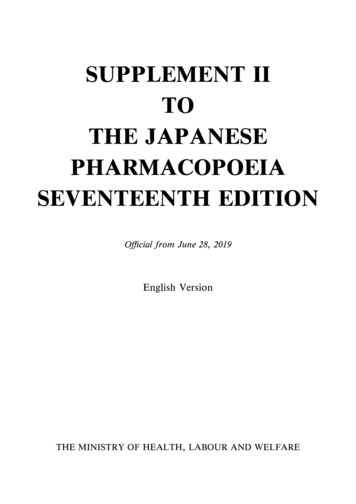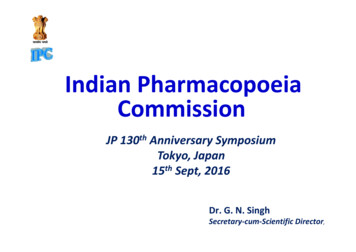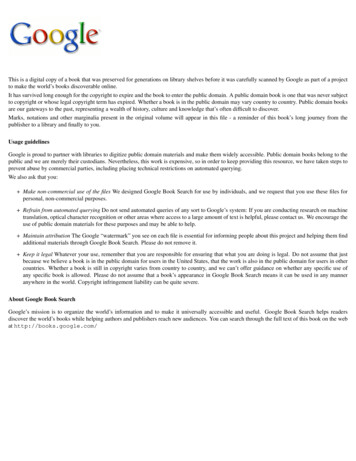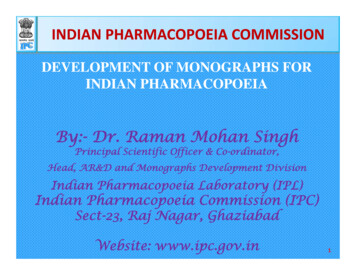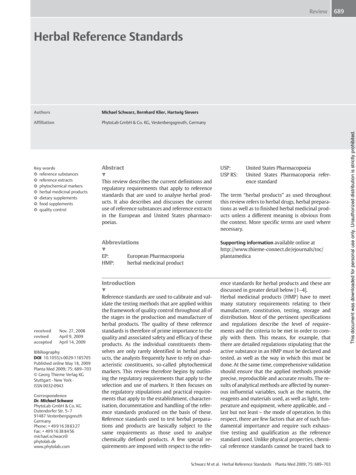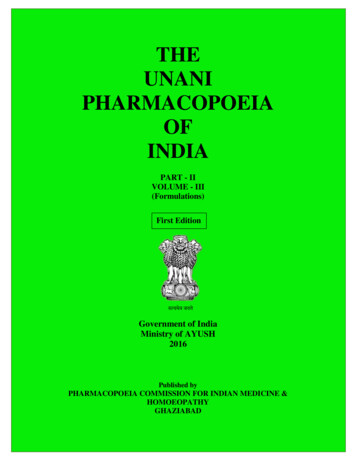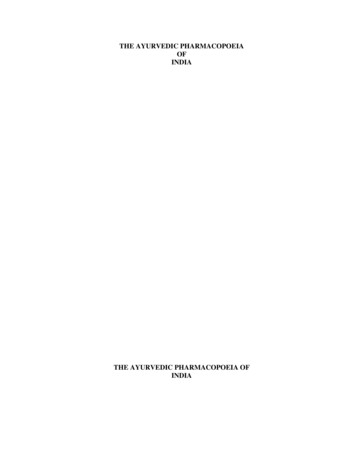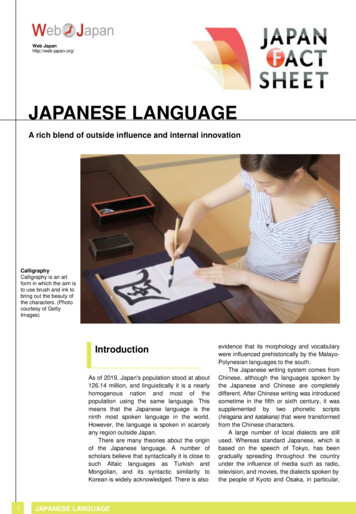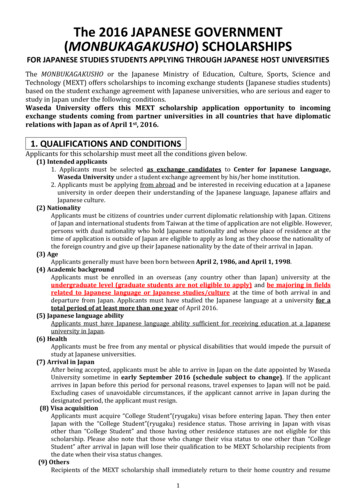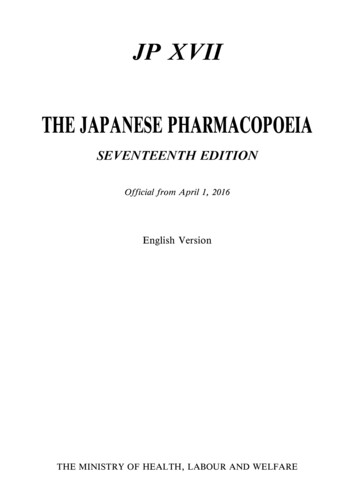
Transcription
JP XVIITHE JAPANESE PHARMACOPOEIASEVENTEENTH EDITIONOfficial from April 1, 2016English VersionTHE MINISTRY OF HEALTH, LABOUR AND WELFARE
Notice: This English Version of the Japanese Pharmacopoeia is publishedfor the convenience of users unfamiliar with the Japanese language. Whenand if any discrepancy arises between the Japanese original and its Englishtranslation, the former is authentic.
The Ministry of Health, Labour andWelfare Ministerial Notification No. 64Pursuant to Paragraph 1, Article 41 of the Law on Securing Quality, Efficacy andSafety of Products including Pharmaceuticals and Medical Devices (Law No. 145,1960), the Japanese Pharmacopoeia (Ministerial Notification No. 65, 2011), whichhas been established as follows*, shall be applied on April 1, 2016. However, in thecase of drugs which are listed in the Pharmacopoeia (hereinafter referred to as previous Pharmacopoeia'') [limited to those listed in the Japanese Pharmacopoeia whosestandards are changed in accordance with this notification (hereinafter referred to as new Pharmacopoeia'')] and have been approved as of April 1, 2016 as prescribedunder Paragraph 1, Article 14 of the same law [including drugs the Minister ofHealth, Labour and Welfare specifies (the Ministry of Health and Welfare MinisterialNotification No. 104, 1994) as of March 31, 2016 as those exempted from marketingapproval pursuant to Paragraph 1, Article 14 of the Same Law (hereinafter referredto as drugs exempted from approval'')], the Name and Standards established in theprevious Pharmacopoeia (limited to part of the Name and Standards for the drugsconcerned) may be accepted to conform to the Name and Standards established in thenew Pharmacopoeia before and on September 30, 2017. In the case of drugs whichare listed in the new Pharmacopoeia (excluding those listed in the previous Pharmacopoeia) and drugs which have been approved as of April 1, 2016 as prescribedunder Paragraph 1, Article 14 of the same law (including those exempted fromapproval), they may be accepted as those being not listed in the new Pharmacopoeiabefore and on September 30, 2017.Yasuhisa ShiozakiThe Minister of Health, Labour and WelfareMarch 7, 2016(The text referred to by the term as follows'' are omitted here. All of them are madeavailable for public exhibition at the Evaluation and Licensing Division, Pharmaceutical Safety and Environmental Health Bureau, Ministry of Health, Labour and Welfare, at each Regional Bureau of Health and Welfare, and at each Prefectural Officein Japan).*The term as follows'' here indicates the contents of the Japanese Pharmacopoeia Seventeenth Editionfrom General Notice to Ultraviolet-visible Reference Spectra (pp. 1 – 2405).
ContentsCONTENTSPreface.iThe Japanese Pharmacopoeia, Seventeenth Edition.1General Notices .1General Rules for Crude Drugs.5General Rules for Preparations.7General Tests, Processes and Apparatus.251. Chemical Methods1.01 Alcohol Number Determination .251.02 Ammonium Limit Test .271.03 Chloride Limit Test.281.04 Flame Coloration Test .281.05 Mineral Oil Test .281.06 Oxygen Flask Combustion Method.281.07 Heavy Metals Limit Test .291.08 Nitrogen Determination (SemimicroKjeldahl Method).301.09 Qualitative Tests.311.10 Iron Limit Test .361.11 Arsenic Limit Test .371.12 Methanol Test.381.13 Fats and Fatty Oils Test .381.14 Sulfate Limit Test .401.15 Readily Carbonizable Substances Test .412. Physical MethodsChromatography2.01 Liquid Chromatography.412.02 Gas Chromatography .442.03 Thin-layer Chromatography .462.04 Amino Acid Analysis of Proteins .46Spectroscopic Methods2.21 Nuclear Magnetic ResonanceSpectroscopy.472.22 Fluorometry .492.23 Atomic AbsorptionSpectrophotometry.492.24 Ultraviolet-visible Spectrophotometry.512.25 Infrared Spectrophotometry .52Other Physical Methods2.41 Loss on Drying Test .532.42 Congealing Point Determination .542.43 Loss on Ignition Test.542.44 Residue on Ignition Test .552.45 Refractive Index Determination .552.46 Residual Solvents.552.47 Osmolarity Determination .612.48 Water Determination (Karl FischerMethod).622.49 Optical Rotation Determination .652.50 Endpoint Detection Methods inTitrimetry .662.512.522.532.542.552.56Conductivity Measurement .68Thermal Analysis.69Viscosity Determination .71pH Determination.74Vitamin A Assay .75Determination of Specific Gravity andDensity .762.57 Boiling Point and Distilling RangeTest .782.58 X-Ray Powder Diffraction Method .792.59 Test for Total Organic Carbon .832.60 Melting Point Determination.842.61 Turbidity Measurement .852.62 Mass Spectrometry.862.63 Inductively Coupled Plasma-AtomicEmission Spectrometry and InductivelyCoupled Plasma-Mass Spectrometry .912.64 Glycosylation Analysis of Glycoprotein .952.65 Methods for Color Matching.963. Powder Property Determinations3.01 Determination of Bulk and TappedDensities .983.02 Specific Surface Area by GasAdsorption .1003.03 Powder Particle DensityDetermination .1033.04 Particle Size Determination .1043.05 Water-Solid Interactions: Determination ofSorption-Desorption Isotherms and ofWater Activity .1084. Biological Tests/Biochemical Tests/Microbial Tests4.01 Bacterial Endotoxins Test .1104.02 Microbial Assay for Antibiotics.1144.03 Digestion Test .1174.04 Pyrogen Test .1204.05 Microbiological Examination of Non-sterileProducts.1214.06 Sterility Test.1305. Tests for Crude Drugs5.01 Crude Drugs Test .1345.02 Microbial Limit Test for Crude Drugs andPreparations containing Crude Drugs asMain Ingredient .1386. Tests for Preparations6.01 Test for Metal Particles in OphthalmicOintments.1476.02 Uniformity of Dosage Units .1476.03 Particle Size Distribution Test forPreparations.1506.04 Test for Acid-neutralizing Capacity ofGastrointestinal Medicines.1506.05 Test for Extractable Volume ofParenteral Preparations .1506.06 Foreign Insoluble Matter Test forInjections .151
Contents6.07Insoluble Particulate Matter Test forInjections .1516.08 Insoluble Particulate Matter Test forOphthalmic Solutions.1546.09 Disintegration Test .1556.10 Dissolution Test .1576.11 Foreign Insoluble Matter Test forOphthalmic Liquids and Solutions .1616.12 Methods of Adhesion Testing .1616.13 Release Test for Preparations for CutaneousApplication .1637. Tests for Containers and Packing Materials7.01 Test for Glass Containers for Injections .1667.02 Test Methods for Plastic Containers.1677.03 Test for Rubber Closure for AqueousInfusions .1729. Reference Standards; Standard Solutions;Reagents, Test Solutions; MeasuringInstruments, Appliances, etc.Reference Standards9.01 Reference Standards .174Standard Solutions9.21 Standard Solutions for VolumetricAnalysis .1779.22 Standard Solutions .1899.23 Matching Fluids for Color .191Reagents, Test Solutions, etc.9.41 Reagents, Test Solutions .1919.42 Solid Supports/Column Packings forChromatography .3529.43 Filter Papers, Filters for filtration,Test Papers, Crucibles, etc. .3549.44 Standard Particles, etc.355Measuring Instruments and Appliances,Thermometers, etc.9.61 Optical Filters for Wavelength andTransmission Rate Calibration .3559.62 Measuring Instruments, Appliances.3559.63 Thermometers .356Official Monographs .359Crude Drugs and Related Drugs .1791Infrared Reference Spectra .2015–2222Ultraviolet-visible Reference Spectra .2225–2405General InformationG1 Physics and ChemistryNear Infrared Spectrometry.2409pH Test for Gastrointestinal Medicine .2412System Suitability.2412Test for Trace Amounts of Aluminum inTotal Parenteral Nutrition (TPN)Solutions .2414Validation of Analytical Procedures .2415G2 Solid-state PropertiesLaser Diffraction Measurement ofJP XVIIParticle Size .2418Measurement of the Diameter of ParticlesDispersed in Liquid by Dynamic LightScattering .2422Powder Fineness .2424Powder Flow.2425Solid and Particle Densities .2427G3 Biotechnological/Biological ProductsAmino Acid Analysis .2428Basic Requirements for Viral Safety ofBiotechnological/Biological Productslisted in Japanese Pharmacopoeia .2435Capillary Electrophoresis .2447Isoelectric Focusing .2452Mass Spectrometry of Peptides andProteins .2454Monosaccharide Analysis and OligosaccharideAnalysis/Oligosaccharide Profiling .2456Mycoplasma Testing for Cell Substrates usedfor the Production of Biotechnological/Biological Products.2460Peptide Mapping.2464Qualification of Animals as Origin ofAnimal-derived Medicinal Productsprovided in the General Notices ofJapanese Pharmacopoeia and OtherStandards .2467SDS-Polyacrylamide Gel Electrophoresis .2469Surface Plasmon Resonance .2474Total Protein Assay .2478G4 MicroorganismsDecision of Limit for BacterialEndotoxins .2481Disinfection and Decontamination Methods.2481Media Fill Test (Process Simulation) .2484Microbial Attributes of Non-sterilePharmaceutical Products .2486Microbiological Environmental MonitoringMethods of Processing Areas for SterilePharmaceutical Products .2489Parametric Release of Terminally SterilizedPharmaceutical Products .2494Preservatives-Effectiveness Tests.2499Rapid Counting of Microbes usingFluorescent Staining.2501Rapid Identification of MicroorganismsBased on Molecular Biological Method .2503Rapid Microbial Methods .2505Sterilization and Sterilization Indicators .2507G5 Crude DrugsAnalytical Methods for Aflatoxins in CrudeDrug and Crude Drug Preparations .2513Aristolochic Acid .2515Notification for the Quantitative MarkerConstituents of Crude Drugs and Crude
JP XVIIDrug Preparations .2515Purity Tests on Crude Drugs using GeneticInformation .2516Quantitative Analytical Technique UtilizingNuclear Magnetic Resonance (NMR)Spectroscopy and its Application to Reagentsin the Japanese Pharmacopoeia.2519On the Scientific Names of Crude Drugslisted in the JP .2520Thin-layer Chromatography for Crude Drugsand Crude Drug Preparations .2534G6 Drug FormulationStandard Procedure for Mechanical Calibrationof Dissolution Apparatus .2536Tablet Friability Test .2538G7 Containers and PackageBasic Requirements and Terms for the Packagingof Pharmaceutical Products.2538Basic Requirements for Plastic Containers forPharmaceutical Use and Rubber Closures forContainers for Aqueous Infusions .2542G8 WaterQuality Control of Water for PharmaceuticalUse .2543Water to be used in the Tests of Drugs .2550G9 Reference StandardsReference Standards and Reference MaterialsSpecified in the Japanese Pharmacopoeia.2550G10 OthersBasic Concepts for Quality Assurance of DrugSubstances and Drug Products .2553Basic Concept of Quality Risk Management.2554International Harmonization Implementedin the Japanese Pharmacopoeia SeventeenthEdition.2557AppendixAtomic Weight Table (2010) .2595Standard Atomic Weights 2010 .2596Index .2599Index in Latin name .2616Index in Japanese.2618Contents
PREFACEThe Japanese Pharmacopoeia (JP) is an officialdocument that defines the specifications, criteria andstandard test methods necessary to properly assure thequality of medicines in Japan.Paragraph 2, Article 41 of the Law on SecuringQuality, Efficacy and Safety of Products includingPharmaceuticals and Medical Devices stipulates thatfull-fledged JP revisions shall be presented at leastevery 10 years. Since the JP 9th edition, full-fledgedrevisions have been made every 5 years. In addition tothe full-fledged revisions, a supplement has beenpromulgated twice in every 5 years since the JP 12thedition as well as partial revisions have been made asnecessary to take account of recent progress of scienceand in the interests of international harmonization.The 16th Edition of the JP was promulgated byMinisterial Notification No. 65 of the Ministry ofHealth, Labour and Welfare (MHLW) on March 24,2011.In July 2011, the Committee on JP established thebasic principles for the preparation of the JP 17th Edition, setting out the roles and characteristics of the JP,the definite measures for the revision, and the date ofthe revision.At the Committee, the five basic principles of JP,which we refer to as the five pillars'', were established as follows: 1) Including all drugs which are important from the viewpoint of health care and medicaltreatment; 2) Making qualitative improvement byintroducing the latest science and technology; 3)Promoting internationalization; 4) Making promptpartial revision as necessary and facilitating smoothadministrative operation; and 5) Ensuring transparency regarding the revision, and disseminating the JP tothe public. It was agreed that the Committee on JPshould make efforts, on the basis of these principles,to ensure that the JP is used more effectively in thefields of health care and medical treatment by takingappropriate measurements, including getting theunderstanding and cooperation of other parties concerned.It was agreed that the JP should provide an officialstandard, being required to assure the quality of medicines in Japan in response to the progress of scienceand technology and medical demands at the time. Itshould define the standards for specifications, as wellas the methods of testing to assure overall quality ofall drugs in principle, and it should have a role inclarifying the criteria for quality assurance of drugsthat are recognized to be essential for public healthand medical treatment. The JP has been prepared withthe aid of the knowledge and experience of manyprofessionals in the pharmaceutical field. Therefore,the JP should have the characteristics of an officialstandard, which might be widely used by all partiesconcerned, and it should play an appropriate role ofproviding information and understanding about thequality of drugs to the public. Moreover, as a pharmaceutical quality standard, it should contributepromoting and maintaining of advancedness as well asinternational consistency and harmonization of technical requirements in the international community. Itwas also agreed that JP articles should cover drugs,which are important from the viewpoint of health careand medical treatment, clinical performance or meritsand frequency of use, as soon as possible after theyreach the market.The target date for the publication of JP 17th Edition (the Japanese edition) was set as April 2016.JP Expert Committees were originally organizedwith the following committees: Expert Committee;Sub-expert Committee; Committee on Chemicals;Committee on Antibiotics; Committee on Biologicals;Committee on Crude Drugs; Committee on Pharmaceutical Excipients; Committee on Physico-ChemicalMethods; Committee on Drug Formulation; Committee on Physical Methods; Committee on BiologicalMethods; Committee on Nomenclature for Pharmaceuticals; Committee on International Harmonization;Committee on Pharmaceutical Water and Committeeon JP Reference Standards. Furthermore, workinggroups were established under the Committee onPhysico-Chemical Methods; Committee on Drug Formulation and Committee on Biological Methods toexpedite discussion on revision drafts. Later, the Expert Committees were reorganized in order to solvetechnical issues with preparation of JP drafts; the Subcommittee on Manufacturing Process-related Matterswas newly established and the Committee on JP Reference Standards was re-formed and renamed Committee on Reference Standards. Moreover, workinggroups were established under the Committee on Pharmaceutical Excipients and Committee on InternationalHarmonization.In the Committee on JP, Mitsuru Hashida took therole of chairman from January 2011 to March 2016.In accordance with the above principles, the committees initiated deliberations on selection of articlesand on revisions for General Notices, General Rulesfor Crude Drugs, General Rules for Preparations,i
iiPrefaceGeneral Tests, Monographs and so on.In order to ensure distribution of drugs in the areahit by the 2011 off the Pacific coast of Tohoku Earthquake on March 11, 2011, for those drugs that weredistributed by the distributors in the same quake-hitarea, the expiry date of interim measure of the Supplement II to the JP 15th Edition under the MinisterialNotification No. 425 of the MHLW dated September30, 2009 was extended to June 30, 2013 and that of thePartial Revision of the JP 15th Edition under theMinisterial Notification No. 322 of the MHLW datedJuly 30, 2010 was extended to January 31, 2012, whichwas promulgated as the partial revision of the preamble of the Ministerial Notification of the JP 16th Edition by Ministerial Notification No. 96 of the MHLWon March 31, 2011, and became effective.Draft revisions covering subjects in General Notices,General Rules for Crude Drugs, General Rules forPreparations, General Tests and Monographs, forwhich discussions were finished between April 2010and March 2012, were prepared for a supplement tothe JP 16. They were examined by the Committee onJP in May 2012, followed by the Pharmaceutical Affairs and Food Sanitation Council (PAFSC) in June2012, and then submitted to the Minister of Health,Labour and Welfare.The supplement was named Supplement I to theJP 16th Edition'', promulgated on September 27, 2012by Ministerial Notification No. 519 of MHLW, andbecame effective on October 1, 2012.Numbers of discussions in the committees to prepare the supplement drafts were as follows: ExpertCommittee (8); Sub-expert Committee (4), Committeeon Chemicals (22), Committee on Antibiotics (5);Committee on Biologicals (9); Committee on CrudeDrugs (21); Committee on Pharmaceutical Excipients(12); Committee on Physico-Chemical Methods (14);Committee on Drug Formulation (19); Committee onPhysical Methods (7); Committee on BiologicalMethods (13); Committee on Nomenclature for Pharmaceuticals (7); Committee on International Harmonization (8); and Committee on Pharmaceutical Water(7).It should be noted that in the preparation of thedrafts for the supplement, generous cooperation wasgiven by the Pharmaceutical Technology Committeeof the Osaka Pharmaceutical Manufacturers Association, the Pharmacopeia and CMC Committee of thePharmaceutical Manufacturers' Association ofTokyo, the Tokyo Crude Drugs Association, the International Pharmaceutical Excipients Council Japan,the Japan Kampo Medicines Manufacturers Association, the Japan Flavor and Fragrance Materials Association, the Japan Medicinal Plant Federation, theJapan Pharmaceutical Manufacturers Association, theParenteral Drug Association Japan Chapter, theJP XVIIJapan Reagent Association, the Japan Oilseed Processors Association, the Home Medicine Association ofJapan, and the Association of Membrane SeparationTechnology of Japan.In consequence of this revision, the JP 16th Editioncarries 1837 articles, owing to the addition of 77 articles and the deletion of 4 articles.Draft revisions covering subjects, the revision of theGeneral Tests and the revision of the specification ofmonograph Gelatin connected with the harmonizationamong the three pharmacopoeias, JP, EP and USPwere examined by the Committee on JP in February2013, followed by PAFSC in April 2013, and then submitted to the Minister of Health, Labour and Welfare.This revision was promulgated on May 31, 2013 byMinisterial Notification No. 190 of MHLW, andbecame effective.Draft revisions covering subjects in General Notices,General Rules for Crude Drugs, General Rules forPreparations, General Tests and Monographs, forwhich discussions were finished between April 2012and September 2013, were prepared for a supplementto the JP 16. They were examined by the Committeeon JP in October 2013, followed by the PAFSC in December 2013, and then submitted to the Minister ofHealth, Labour and Welfare.The supplement was named Supplement II to theJP 16th Edition'' and promulgated on February 28,2014 by Ministerial Notification No. 47 of MHLW,and became effective.Numbers of discussions in the committees to prepare the supplement drafts were as follows: ExpertCommittee (5); Sub-committee on ManufacturingProcess-related Matters (6); Committee on Chemicals(16); Committee on Antibiotics (3); Committee onBiologicals (8); Committee on Crude Drugs (16); Committee on Pharmaceutical Excipients (12); Committeeon Physico-Chemical Methods (9); Committee onDrug Formulation (14); Committee on BiologicalMethods (13); Committee on Nomenclature for Pharmaceuticals (4); Committee on International Harmonization (10); and Committee on Reference Standards(1).It should be noted that in the preparation of thedrafts for the supplement, generous cooperation wasgiven by the Pharmaceutical Technology Committeeof the Osaka Pharmaceutical Manufacturers Association, the Pharmacopeia and CMC Committee of thePharmaceutical Manufacturers' Association ofTokyo, the Tokyo Crude Drugs Association, the International Pharmaceutical Excipients Council Japan,the Japan Kampo Medicines Manufacturers Association, the Japan Flavor and Fragrance Materials Association, the Japan Medicinal Plant Federation, theJapan Pharmaceutical Manufacturers Association, theFederation of Pharmaceutical Manufacturers' Associ-
JP XVIIation of Japan, the Parenteral Drug Association JapanChapter, the Japan Reagent Association, the JapanOilseed Processors Association, the Home MedicineAssociation of Japan, the Association of MembraneSeparation Technology of Japan, the External Pharmaceutical Association, the Japan Alcohol Association and the Pharmacopoeial Drug Society.In consequence of this revision, the JP 16th Editioncarries 1896 articles, owing to the addition of 60 articles and the deletion of 1 article.In accordance with the change of the title fromPharmaceutical Affairs Law (Act No. 145 of 1960) toLaw on Securing Quality, Efficacy and Safety ofProducts including Pharmaceuticals and MedicalDevices by the Law for Partial Revision of the Pharmaceutical Affairs Law (Act No. 84 of 2013), the partial revision to change from Pharmaceutical AffairsLaw'' to Law on Securing Quality, Efficacy andSafety of Products including Pharmaceuticals andMedical Devices'' in JP General Notices was promulgated on November 21, 2014 by Ministerial Notification No. 439 of MHLW, and became effective.Draft revisions covering subjects in General Notices,General Rules for Crude Drugs, General Rules forPreparations, General Tests and Monographs, forwhich discussions were finished between October 2013and July 2015, were prepared for a supplement to theJP 17. They were examined by the Committee on JP inAugust 2015, followed by the PAFSC in September2015, and then submitted to the Minister of Health,Labour and Welfare.Numbers of discussions in the committees to prepare the supplement drafts were as follows: ExpertCommittee (7); Sub-committee on ManufacturingProcess-related Matters (12); Committee on Chemicals(22); Committee on Antibiotics (8); Committee onBiologicals (11); Committee on Crude Drugs (21);Committee on Pharmaceutical Excipients (10, including working group); Committee on Physico-ChemicalMethods (9, including working group); Committee onDrug Formulation (23, including working group);Committee on Physical Methods (7); Committee onBiological Methods (12, including working group);Committee on Nomenclature for Pharmaceuticals (6);Committee on International Harmonization (10, including working group); and Committee on ReferenceStandards (8).It should be noted that in the preparation of thedrafts for the supplement, generous cooperation wasgiven by the Pharmaceutical Technology Committeeof the Osaka Pharmaceutical Manufacturers Association, the Pharmacopeia and CMC Committee of thePharmaceutical Manufacturers' Association ofTokyo, the Tokyo Crude Drugs Association, the International Pharmaceutical Excipients Council Japan,the Home Medicine Association of Japan, the JapanPrefaceiiiKampo Medicines Manufacturers Association, theJapan Flavor and Fragrance Materials Association,the Japan Medicinal Plant Federation, the JapanPharmaceutical Manufacturers Association, theFederation of Pharmaceutical Manufacturers' Association of Japan, the Parenteral Drug Association JapanChapter, the Japan Reagent Association, the JapanOilseed Processors Association, the Association ofMembrane Separation Technology of Japan, the External Pharmaceutical Association, the Japan AlcoholAssociation, and the Pharmacopoeial Drug Society.In consequence of this revision, the JP 17th Editioncarries 1962 articles, owing to the addition of 76 articles and the deletion of 10 articles.The principles of description and the salient pointsof the revision in this volume are as follows:1. The JP 17th Edition comprises the followingitems, in order: Notification of MHLW; Contents;Preface; General Notices; General Rules for CrudeDrugs; General Rules for Preparations; General Tests,Processes and Apparatus; Official Monographs; thenfollowed by Infrared Reference Spectra and Ultraviolet-visible Reference Spectra; General Information;Table of Standard Atomic Weights as an appendix;and a Cumulative Index.2. The articles in Official Monographs, InfraredReference Spectra and Ultraviolet-visible ReferenceSpectra are respectively placed in alphabetical order inprinciple.3. The following items in each monograph are putin the order shown below, except that unnecessaryitems are omitted depending on the nature of the drug:(1) English title(2) Commonly used name(s)(3) Latin title (only for crude drugs)(4) Title in Japanese(5) Structural formula or empirical formula(6) Molecular formula and molecular mass(7) Chemical name(8) Chemical Abstracts Service (CAS) RegistryNumber(9) Origin(10) Limits of the content of the ingredient(s) and/orthe unit of potency(11) Labeling requirements(12) Method of preparation(13) Manufacturing requirement(14) Description(15) Identification tests(16) Specific physical and/or chemical values(17) Purity tests(18) Potential adulteration(19) Loss on drying or Ignition, or Water(20) Residue on ignition, Total ash or Acid-insolubleash
iv(21)(22)(23)(24)(25)(26)PrefaceTests being required for pharmaceutical preparationsOther special testsAssayContainers and storageShelf lifeOthers4. In each monograph, the following physical andchemical values representing the properties and qualityof the drug are given in the order indicated below, except that unnecessary items are omitted depending onthe nature of drug:(1) Alcohol number(2) Absorbance(3) Congealing point(4) Refractive index(5) Osmolar ratio(6) Optical
1960), the Japanese Pharmacopoeia (Ministerial Notification No. 65, 2011), which has been established as follows*, shall be applied on April 1, 2016. However, in the caseof drugswhich are listed in the Pharmacopoeia (hereinafter referred to as previ-ous Pharmacopoeia'') [limited to those listed in the Japanese Pharmacopoeia whose
